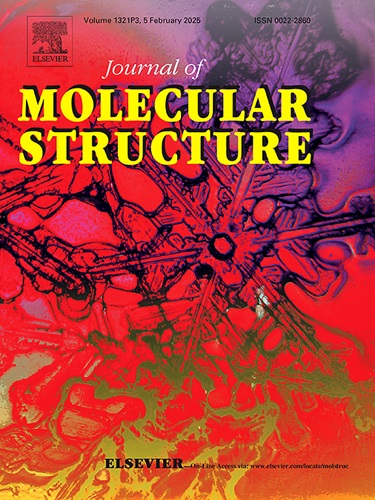Design, synthesis, and computational studies of novel pyrazoline-based dual EGFR/HER-2 inhibitors with apoptotic antiproliferative activity
IF 4
2区 化学
Q2 CHEMISTRY, PHYSICAL
引用次数: 0
Abstract
The simultaneous targeting of EGFR and HER2 constitutes a legitimate anticancer strategy for the treatment of solid tumors. In response, we developed and synthesized a new group of pyrazoline compounds that act as dual-target inhibitors for EGFR and HER-2. The structure of the newly synthesized compounds was validated with 1H NMR, 13C NMR, and elemental analysis. The novel compounds' antiproliferative efficacy was evaluated against four cancer cell lines. All compounds showed GI50 values ranging from 23 to 66 nM, with the breast cancer cell line (MCF-7) showing the highest sensitivity. Compounds 7c, 7d, 7f, 7h, 7j, and 7l had the strongest antiproliferative activity, with derivatives 7d, 7h, and 7j outperforming erlotinib in all tested cancer cell lines. The study revealed that compounds 7d and 7h are the most effective dual-target inhibitors of EGFR and HER-2, exceeding the reference EGFR inhibitor erlotinib and having comparable action to the clinically used HER-2 medication Lapatinib. We tested the apoptotic potential of 7d and 7h and found that both compounds cause apoptosis by turning on caspase-3, caspase-8, and Bax and decreasing the expression of Bcl-2, a protein that prevents apoptosis. Molecular docking studies revealed robust interactions of these compounds within the EGFR and HER-2 binding pockets, supported by molecular dynamics simulations that confirmed their stability. ADME profiling highlighted the pharmacokinetic advantages of these compounds, particularly 7h, as orally bioavailable and effective inhibitors. These findings suggest that pyrazoline-based inhibitors could serve as a foundation for future development of dual-targeted therapies to overcome resistance in cancer treatment.
具有凋亡抗增殖活性的新型吡唑啉类双EGFR/HER-2抑制剂的设计、合成和计算研究
同时靶向EGFR和HER2是治疗实体瘤的一种合理的抗癌策略。作为回应,我们开发并合成了一组新的吡唑啉化合物,作为EGFR和HER-2的双靶点抑制剂。通过1H NMR、13C NMR和元素分析对新合成化合物的结构进行了验证。新化合物对四种肿瘤细胞系的抗增殖作用进行了评价。所有化合物的GI50值范围为23 ~ 66 nM,其中对乳腺癌细胞系(MCF-7)的敏感性最高。化合物7c、7d、7f、7h、7j和7l具有最强的抗增殖活性,衍生物7d、7h和7j在所有测试的癌细胞系中都优于厄洛替尼。研究显示,化合物7d和7h是最有效的EGFR和HER-2双靶点抑制剂,超过参考EGFR抑制剂厄洛替尼,与临床使用的HER-2药物拉帕替尼的作用相当。我们检测了7d和7h的凋亡电位,发现这两种化合物都通过打开caspase-3、caspase-8和Bax,降低Bcl-2(一种阻止细胞凋亡的蛋白)的表达而导致细胞凋亡。分子对接研究揭示了这些化合物在EGFR和HER-2结合口袋内的强大相互作用,分子动力学模拟证实了它们的稳定性。ADME分析强调了这些化合物的药代动力学优势,特别是7h,作为口服生物可利用和有效的抑制剂。这些发现表明,基于吡唑啉的抑制剂可以作为未来发展双靶向治疗的基础,以克服癌症治疗中的耐药性。
本文章由计算机程序翻译,如有差异,请以英文原文为准。
求助全文
约1分钟内获得全文
求助全文
来源期刊

Journal of Molecular Structure
化学-物理化学
CiteScore
7.10
自引率
15.80%
发文量
2384
审稿时长
45 days
期刊介绍:
The Journal of Molecular Structure is dedicated to the publication of full-length articles and review papers, providing important new structural information on all types of chemical species including:
• Stable and unstable molecules in all types of environments (vapour, molecular beam, liquid, solution, liquid crystal, solid state, matrix-isolated, surface-absorbed etc.)
• Chemical intermediates
• Molecules in excited states
• Biological molecules
• Polymers.
The methods used may include any combination of spectroscopic and non-spectroscopic techniques, for example:
• Infrared spectroscopy (mid, far, near)
• Raman spectroscopy and non-linear Raman methods (CARS, etc.)
• Electronic absorption spectroscopy
• Optical rotatory dispersion and circular dichroism
• Fluorescence and phosphorescence techniques
• Electron spectroscopies (PES, XPS), EXAFS, etc.
• Microwave spectroscopy
• Electron diffraction
• NMR and ESR spectroscopies
• Mössbauer spectroscopy
• X-ray crystallography
• Charge Density Analyses
• Computational Studies (supplementing experimental methods)
We encourage publications combining theoretical and experimental approaches. The structural insights gained by the studies should be correlated with the properties, activity and/ or reactivity of the molecule under investigation and the relevance of this molecule and its implications should be discussed.
 求助内容:
求助内容: 应助结果提醒方式:
应助结果提醒方式:


